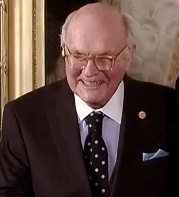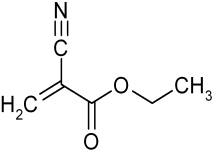Harry Coover and Super Glue
March 29, 2011
Many unique materials have been
discovered by accident.
Teflon (Polytetrafluoroethylene) was discovered during
research on new
chlorofluorocarbon (Freon-type) refrigerants. During the course of this research, it was found that a
cylinder of
tetrafluoroethylene gas contained less gas than its weight would indicate. When an empty cylinder was cut open to discover why this was happening, its insides were coated with a
polymer of tetrafluoroethylene, the polymerization reaction having been catalyzed by the
iron cylinder.
Polytetrafluoroethylene wasn't the first polymer to have been discovered by accident.
polyethylene was produced accidentally when
diazomethane was heated. This happened in 1858, but it wasn't until 1935 that a viable commercial process was developed for polyethylene production.
In 1952, a
scientist at
Corning Glass was doing research on
photosensitive glass, when he discovered that an accidental
heat-treatment rendered the glass milky white. He found that this glass was particularly resistant to breakage, and so
pyroceram, a.k.a. Corningware®, was born.[1] The material attains its unique properties from the fact that the
crystallized ceramic inside the glass has very fine dimension. This gives a
resistance to crack propagation and increased
tensile strength to the hundred
MPa (15
ksi) range. For comparison, the
yield strength of
A36 structural steel is about 250 MPa (35 ksi).
All these accidental discoveries were not truly accidental. Although the
phenomena may have happened by chance, the scientist who correctly observed an opportunity was an important element. As
Louis Pasteur said, "
In the fields of observation, chance favors only the prepared mind."[2] It was an observation by the prepared mind of
Harry Wesley Coover, Jr. that gave us
Eastman 910,
Super Glue and its derivatives. Harry Coover died on March 26, 2011, at the age of 94.[3-5]

Harry Wesley Coover, Jr.,
on November 17, 2010.
(Screen capture of White house National Medal of Technology and Innovation Ceremony)
Harry Wesley Coover, Jr. was born on March 6, 1917, in Newark, Delaware. Coover earned a Bachelor of Science degree in
chemistry at
Hobart College,
Geneva, New York, and he continued at nearby
Cornell University for his M.S. and Ph.D. chemistry degrees. Coover then worked as a chemist at
Eastman Kodak, finally serving as a Kodak vice president and director of research and development and new venture management at the
Eastman Chemical Division from 1973-1984.[6]
Coover discovered
cyanoacrylate, the chemical behind Super Glue, in 1942 while looking for clear plastic materials for gun sights. This class of
organics was discounted as being too sticky. It wasn't until 1951, when Coover was looking for a lightweight material for
jet fighter canopies, that his coworker, Fred Joyner, attempted to measure the
refractive index of their 910th compound. This cyanoacrylate stuck the
optical prisms together so tightly that they couldn't be separated. Thus was born Eastman 910, the first Super Glue.[4]
Coover filed a patent application on this discovery in November, 1952, and a patent was issued in 1956.[7] The product was first sold in 1958.[5] The Super Glue patent was just one of Coover's 460 lifetime patents. Coover also patented the use of these adhesives as a means of bonding tissue, and they were used first during the
Vietnam War to temporarily mend wounded soldiers. Now, they are often used in many
surgical procedures.

Ethyl cyanoacrylate (ECA), the ethyl ester of 2-cyano-2-propenoic acid.
ECA polymerizes rapidly in the presence of moisture, and it's the material used in Super Glue.
(Via Wikimedia Commons))
Unfortunately, Super Glue did not become a commercial success until its patents expired; or, perhaps we should say, it became a success
because its patents expired. So many imitators have entered the market that it's a common and relatively inexpensive household item. Kodak sold its Super Glue business to
National Starch in 1980.[4]
Coover was inducted into the
National Inventor's Hall of Fame in 2004.[8] He received the
National Medal of Technology and Innovation from
US President Barack Obama in 2010. Along with his many patents, Coover wrote sixty scientific papers on
polymer chemistry.[6] After retirement from Kodak, Coover maintained his interest in the Super Glue industry by becoming president of new business development for
Loctite Corporation,
Newington, Connecticut. Coover was a member of the board of directors of
Reilly Industries (now Vertellus Specialties Inc),
Indianapolis, Indiana, for nine years.[6]
Coover appeared on the popular television series, "
I've got a Secret." Coover's secret, of course, was that he had invented this powerful adhesive. As a demonstration on live television, Coover bonded two metal bars together with a drop of the glue. Then, he and host,
Gary Moore, were suspended in air on the strength of that instantly-setting bond.[4]
References:
- Corning® Pyroceram® Glass-Ceramic Story, Corning Web Site.
- "Dans les champs de l'observation le hasard ne favorise que les esprits préparés," Louis Pasteur's Lecture on December 7, 1854, at the University of Lille (Via Wikiquote).
- Harry Wesley Coover Jr. Obituary on Legacy.com.
- Elizabeth A. Harris, "Harry Coover, Super Glue’s Inventor, Dies at 94," New York Times, March 27, 2011.
- Harry Coover, Creator Of Super Glue, Dies At 94, NPR Web Site, March 27, 2011.
- Coover/Super Glue, Lemelson-MIT Inventor of the Week Archive, MIT, September 2004.
- Harry W. Coover Jr., "Alcohol-Catalyzed Cyanoacrylate Adhesive Compositions," US Patent No. 2,768,109, October 23, 1956.
- Harry Coover, Inventor's Hall of Fame Web Site.
Permanent Link to this article
Linked Keywords: Serendipity; discovered by accident; polytetrafluoroethylene; Teflon; research; chlorofluorocarbon; gas cylinder; tetrafluoroethylene gas; polymer; iron; polyethylene; diazomethane; scientist; Corning Incorporated; Corning Glass; photosensitive glass; heat-treatment; pyroceram; crystallization; ceramic; resistance to crack propagation; tensile strength; MPa; ksi; yield strength; A36 structural steel; phenomenon; Louis Pasteur; In the fields of observation, chance favors only the prepared mind; Harry Wesley Coover, Jr.; Eastman 910; Super Glue; chemistry; Hobart College; Geneva, New York; Cornell University; Eastman Kodak; Eastman Chemical Company; cyanoacrylate; organic compound; jet fighter; aircraft canopy; refractive index; optical prism; Vietnam War; surgical procedure; Wikimedia Commons; National Starch; National Inventor's Hall of Fame; National Medal of Technology and Innovation; US President Barack Obama; polymer chemistry; Loctite Corporation; Newington, Connecticut; Reilly Industries; Vertellus Specialties Inc.; Indianapolis, Indiana; I've got a Secret; Gary Moore; US Patent No. 2,768,109.